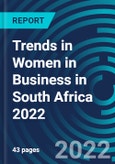Introduction
Women in South Africa have achieved near parity with men in parliament, politics and the judiciary. The country was ranked 18 out of 156 countries in the World Economic Forum’s 2021 Global Gender Gap Index. However, women are still significantly under-represented in business and continue to earn less than their male counterparts. Despite the percentage of women in leadership positions in business growing steadily in recent years, women in South Africa make up just over a quarter of top management in the private and public sectors. The percentage of women involved in early-stage entrepreneurial activity is less than the number of men, and businesses started by men report more profits . Despite many challenges, including gender-based violence, access to finance and land, the increased focus on environmental, social and governance has led to growing demand for female executives, gender parity in pay and funding of female entrepreneurs.Opportunities
A 40% procurement set-aside for women has been proposed by government.BEE legislation and employment equity incentivise companies to hire more women managers and procure from and support black women-owned enterprises. Demand for female executives. Gender-lens investing, where financiers invest in businesses that improve the situation of women. Mentoring female artisans. Programmes to encourage women in science, engineering and technology. Providing finance and business support to women entrepreneurs.
Outlook
Despite facing numerous challenges, women have made progress in several areas in South Africa. However, women are still underrepresented in business in the private and public sector and continue to be paid less than their male counterparts, while fewer women than men start and run businesses. Government is looking to support female entrepreneurs through dedicated funds, support programmes and procurement set-asides. Corporate financiers are increasingly seeking to fund female entrepreneurs and female empowerment initiatives through dedicated funds and funding mechanisms. There is still a significant way to go to reach gender parity for women in business.Report Coverage
This Trends report on women in business includes the latest available statistics on women in business including the numbers qualifying and at various levels of business, barriers to women in business and initiatives to close gaps in terms of hiring women, procuring from women-owned businesses and narrowing the salary gap.The report collates information to provide an overall picture of women in business in South Africa including trends, developments and initiatives and the outlook for women in South Africa’s business environment.
Selected Highlights
Entrepreneurship In 2021, 16.2% of South African women between 18 and 64 years were involved in early-stage entrepreneurial activity (starting or running a business), up from 9.6% in 2019, according to the Global Entrepreneurship Monitor (GEM) report. In comparison, 18.
2% of men were involved in early-stage entrepreneurial activity
In 2019, women made up a 175,000, or a quarter of the 701,000 formal business owners, and 681,000 or two fifths of the 1.7 million informal business owners, according to economic research institution Trade and Industrial Policy Strategies
Women-owned small and medium-sized enterprises (SMEs) in South Africa generate 65% less profits than their male counterparts, according to a 2019 World Bank report titled Profiting from Parity. This is higher than the average among 14 sub-Saharan African countries, where male-owned SMEs generated on average 34% more in profits than their female counterparts. The large difference in profitability between female and male businesses can partly be explained by women’s greater tendency to be involved in necessity entrepreneurship (starting a business out of a need to survive, rather than out of an opportunity) over opportunity-based entrepreneurshipStrengths
A number of government departments have developed strategies to increase the representation of women in industry sectors.
Significant progress has been made in politics, the judicial system and civil service to reach near gender parity. The constitution recognises the equality of men and women. The number of female university graduates exceeds those of male graduates.
Threats
Gender-based violence threatens to undermine women’s economic gains.Large number of single-headed households where women are the main breadwinners. More women are unemployed than men. Slowing economy reduces opportunities for women in business. Traditional societal attitudes that women are subordinate to men.
Weaknesses
A lack of childcare services places an additional burden on mothers. A lack of land rights in traditional areas disenfranchises rural women. A shortage of skilled female executives. The lack of overarching legislation to incentivise women empowerment (other than BEE and employment equity laws). The tax system shows a bias against single mothers. Women (particularly black women) are under-represented in top and senior management in the private sector. Women are paid an average of 30% less for the same work as male counterparts. Women struggle to access financeTable of Contents
1. INTRODUCTION4. AFRICA5. INTERNATIONAL7. SWOT ANALYSIS8. OUTLOOK9. INDUSTRY ASSOCIATIONS
2. OVERVIEW OF WOMEN IN BUSINESS
3. STATE OF PLAY OF WOMEN IN BUSINESS
6. INFLUENCING FACTORS
10. REFERENCES
Methodology

LOADING...







![List of the 200 Largest Companies Berlin [2023 Update] - Product Image](http://www.researchandmarkets.com/product_images/12575/12575993_60px_jpg/list_of_the_200_largest_companies_berlin_[2023_update].jpg)
